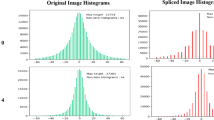Abstract
In recent years, improper image manipulation has become a significant issue across many sectors, such as in the education field, politics, entertainment sector, and social media platforms. In various society sectors, images play a crucial role in interpreting the facts and number of fraud incidents. The fraud and fact can be detected by image manipulation, which is gaining more and more attention in today’s world. Detecting such manipulations images is a major challenging problem concerning many fragmented images’ unavailability as training data. A learning algorithm has been proposed for recognizing many visually spliced images and manipulations in the image. The proposed algorithm also utilizes the existing recorded image Exchangeable Image File Format (EXIF) metadata as a supervisory image for training the model to identify the image is self-consistent, i.e., whether the content of the photo has been generated using a single imaging pipeline. The proposed algorithm is implemented to the errand of identifying and localizing the image splices. An excellent performance improvement has been observed on several benchmarks, despite not using any spliced image data while training. This model will stand out as a vital source to detect morphed images in various industries.
Access this chapter
Tax calculation will be finalised at checkout
Purchases are for personal use only
Similar content being viewed by others
References
Zhou, P., Han, X., Morariu, V.I., Davis, L.S.: Two-stream neural networks for tampered face detection. In: 2017 IEEE Conference on Computer Vision and Pattern Recognition Workshops (CVPRW), pp. 1831–1839. IEEE (2017). https://doi.org/10.1109/CVPRW.2017.229
Ghosh, P., Morariu, V., Larry Davis B.-C.I.S.: Detection of metadata tampering through discrepancy between image content and metadata using multi-task deep learning. In: Proceedings of the IEEE Conference on Computer Vision and Pattern Recognition Workshops, pp. 60–68 (2017). https://doi.org/10.1109/CVPRW.2017.234
Kniaz, V.V., Knyaz, V., Remondino, F.: The point where reality meets fantasy: Mixed adversarial generators for image splice detection. In: Advances in Neural Information Processing Systems, pp. 215–226 (2019)
de Sa, V.R.: Learning classification with unlabeled data. In: Advances in Neural Information Processing Systems, pp. 112–119 (1994). https://doi.org/10.5555/2987189.2987204
Ferrara, P., Bianchi, T., De Rosa, A., Piva, A.: Image forgery localization via fine-grained analysis of CFA artifacts. IEEE Trans. Inf. Forensics Secur. 7(5), 1566–1577 (2012). https://doi.org/10.1109/TIFS.2012.2202227
Ye, S., Sun Q., Chang, E.-C.: Detecting digital image forgeries by measuring inconsistencies of blocking artifact. In: 2007 IEEE International Conference on Multimedia and Expo, pp. 12–15. IEEE (2007). https://doi.org/10.1109/ICME.2007.4284574
Cun, X., Pun, C.-M.: Image splicing localization via semi-global network and fully connected conditional random fields. In: Proceedings of the European Conference on Computer Vision (ECCV) (2018)
Salloum, R., Ren, Y., C-C. Jay Kuo (2018) Image splicing localization using a multi-task fully convolutional network (MFCN). J. Vis. Commun. Image Represent. 51, 201–209 (2018). https://doi.org/10.1016/j.jvcir.2018.01.010
Mayer, O., Stamm, M.C.: Learned forensic source similarity for unknown camera models. In: 2018 IEEE International Conference on Acoustics, Speech and Signal Processing (ICASSP), pp. 2012–2016. IEEE (2018). https://doi.org/10.1109/ICASSP.2018.8462585
Agarwal, S., Farid, H.: Photo forensics from JPEG dimples. In: 2017 IEEE Workshop on Information Forensics and Security (WIFS), pp. 1–6. IEEE (2017). https://doi.org/10.1109/WIFS.2017.8267641
Bondi, L., Lameri, S., Güera, D., Bestagini, P., Delp, E.J., Tubaro, S.: Tampering detection and localization through clustering of camera-based CNN features. In: 2017 IEEE Conference on Computer Vision and Pattern Recognition Workshops (CVPRW), pp. 1855–1864. IEEE (2017). https://doi.org/10.1109/CVPRW.2017.232
Doersch, C., Gupta, A., Efros, A.A.: Unsupervised visual representation learning by context prediction. In: Proceedings of the IEEE International Conference on Computer Vision, pp. 1422–1430 (2015). https://doi.org/10.1109/ICCV.2015.167
Author information
Authors and Affiliations
Editor information
Editors and Affiliations
Rights and permissions
Copyright information
© 2022 The Author(s), under exclusive license to Springer Nature Singapore Pte Ltd.
About this paper
Cite this paper
Priya, B.K., Das, A., Begum, S., Ramasubramanian, N. (2022). Studies on Performance of Image Splicing Techniques Using Learned Self-Consistency. In: Iyer, B., Ghosh, D., Balas, V.E. (eds) Applied Information Processing Systems . Advances in Intelligent Systems and Computing, vol 1354. Springer, Singapore. https://doi.org/10.1007/978-981-16-2008-9_24
Download citation
DOI: https://doi.org/10.1007/978-981-16-2008-9_24
Published:
Publisher Name: Springer, Singapore
Print ISBN: 978-981-16-2007-2
Online ISBN: 978-981-16-2008-9
eBook Packages: Intelligent Technologies and RoboticsIntelligent Technologies and Robotics (R0)




